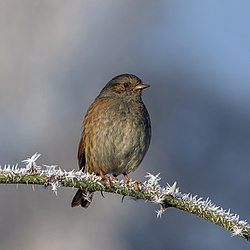Taxonomy and etymology
The genus Prunella was introduced by the French ornithologist Louis Vieillot in 1816 with the dunnock (Prunella modularis) as the type species. [3] [4] Although the genus is usually used for all the accentors, the alpine accentor and Altai accentor are sometimes separated into the genus Laiscopus. [5]
Harrison [6] used the group name dunnock for all of the species, not just Prunella modularis (thus e.g. Japanese dunnock for P. rubida); this usage is based on the oldest known name for any of the species (old English dun-, brown, + -ock, small: "little brown bird" [7] ). Accentor derives from the old scientific name for the Alpine accentor (Accentor collaris). It comes from Late Latin, meaning "sing with another" (ad + cantor). [8] The genus name Prunella is from the German Braunelle, "dunnock", a diminutive of braun, "brown". [9]
Description
These are small, fairly drab species superficially similar, but not closely related to, sparrows. They are 14 to 18 cm in length, and weigh between 25 and 35 g. [2] However, accentors have thin sharp bills, reflecting their diet of ground-dwelling insects in summer, augmented with small seeds and berries in winter. They may also swallow grit and sand to help their stomach break up these seeds. [5] [10]
Most of the species live together in flocks. The dunnock is an exception since it prefers to be solitary except when feeding. The dunnock also earned a nickname of "shuffle-wing" since it most strongly displays the characteristic wing flicks used during courtship and other displays. [10]
Accentors may have one to three broods a year. Courtship consists of a great deal of song from the males, which may include short lark-like song flights to attract a mate. In most species, the male and female share in the nest making, with the dunnocks again being an exception; their males have no part in nest building or incubation. They build neat cup nests and lay 3–6 unspotted green or blue eggs. [5] [2] The eggs are incubated for around 12 days. The young are fed by both parents and take an additional 12 days or so to fledge. [5]
Habitat
Their typical habitat is mountainous regions in an area far above the tree-line, but below the snow-line. The Alpine accentor has been observed at nearly 8,000 m (26,000 ft) altitude in the Himalaya and the Altai and Robin accentors at 5,500 m (18,000 ft); [5] however, most accentors breed in scrub vegetation at lower levels. Most species are altitudinal migrants, descending to lower altitudes to spend the winter, but some are long-distance migrants, most notably the Siberian accentor, which migrates 3,000–5,000 km from northern Siberia to China and Korea. [5] Accentors spend the majority of their time in the undergrowth and even when flushed, stay low to the ground until reaching cover. [5]
This page is based on this
Wikipedia article Text is available under the
CC BY-SA 4.0 license; additional terms may apply.
Images, videos and audio are available under their respective licenses.
